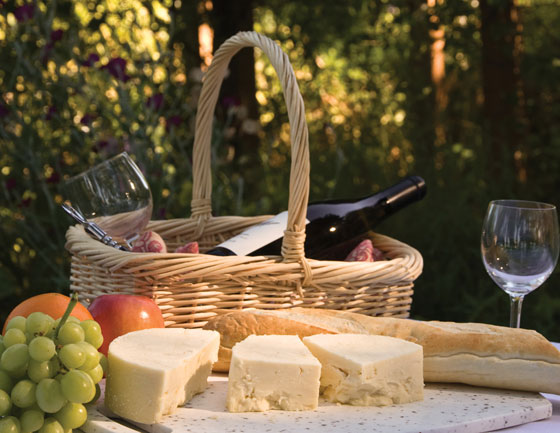If you haven’t tried Cougar Gold cheese, you’re in for a real treat—this aged cheddar is a satisfying and versatile companion to a wealth of wines
Click here for simple recipes using Cougar Gold Cheese, featured in the Fall 2010 issue of Tasting Room Magazine.
Wine and cheese are meant to go together. Another natural pairing, it seems, is for an academic institution with a wine education program on the magnitude of Washington State University’s to also make world-class cheese.
A HERO IN EVERY CAN
Cougar Gold hearkens back to the late 1930’s when food scientists at Washington State University (WSU) tried to figure out how to package hard cheese in cans—plastic wrap hadn’t been invented yet, and cheese at the time was sealed in wax, which was susceptible to cracking and spoilage. When World War II broke out in Europe in 1939, the U.S. government helped fund WSU research to meet the need for more canned foods.
The main obstacle toward packaging cheese in a can was that the carbon dioxide produced by bacteria in the cheese caused the cans to bulge and even burst. Finally, one of the professors discovered that by adding a second culture to the cheese, simply known as “WSU 19”, solved the carbon dioxide problem. It’s also this extra culture that transforms a standard cheddar culture into the unique flavor and finish of Cougar Gold cheese.
The formula for this cheese that began in 1940 remains relatively unchanged, and it is still packaged in a sturdy, airtight can.
TASTING NOTES
Cutting off a wedge of the 30 oz. wheel shows off its strikingly rustic and non-uniform edges speckled with shiny crystals. Considered a hard cheese, the texture is slightly crumbly, with a stippled coarseness. The first bite reveals subtle notes of mellow crème fraiche that yield to a wave of delightful sharp tanginess (a sign of maturity from aging a year), with a hint of sour tartness that balances quickly with a flutter of sea-salt. Unlike average cheddar, the finish evolves into a long and buttery creaminess that lingers long after the bite is gone.
WHAT TO SIP
A panel of 16 independent culinary experts concluded that Cougar Gold goes down best with Viognier, Savignon Blanc, Pinot Noir and Merlot, but we would add that this is a versatile cheese when it comes to pairing wines (as many cheeses are found to be). Drier wines and those with slightly higher acidity help cut the butter fat in the cheese and bring out harmonious flavors in both the wine and food, but we recommend trying Cougar Gold with your personal favorites.
PACK A PICNIC
Pair Cougar Gold with antipasto dishes such as salamis, cold cuts, rustic breads and crackers, and sweet fruits lower in acid like apples and grapes. Of course, you could simply make a meal of the cheese!
FEEL GOOD CHEESE
The Creamery, on the WSU campus in Pullman, is self-funded and provides jobs for 70 college students and 11 full-time staff members. The students gain valuable work experience in a state-of-the-art facility at the forefront of research in cheese production. They produce 220,000 cans of Cougar Gold per year that are sold to customers worldwide.
AGING TIP
Stock up now and let the cheese age unopened in the refrigerator until you’re ready to serve during a special occasion or holiday party. With aging, the cheese becomes more flavorful, sharp, dry, and crumbly. Your guests will be amazed at the depth of aged flavors.
WHERE TO FIND COUGAR GOLD AGED CHEDDAR
Cougar Gold is sold at the Washington State Connections Store in the Westlake Mall and in bookstores at WSU campuses in Spokane, Richland and Vancouver, and a few wineries. Or you can order online at www.wsu.edu/creamery or phone 800-457-5442 and have it shipped directly to your door. Cost is $18 per 30-ounce can.
Written by John Vitale

